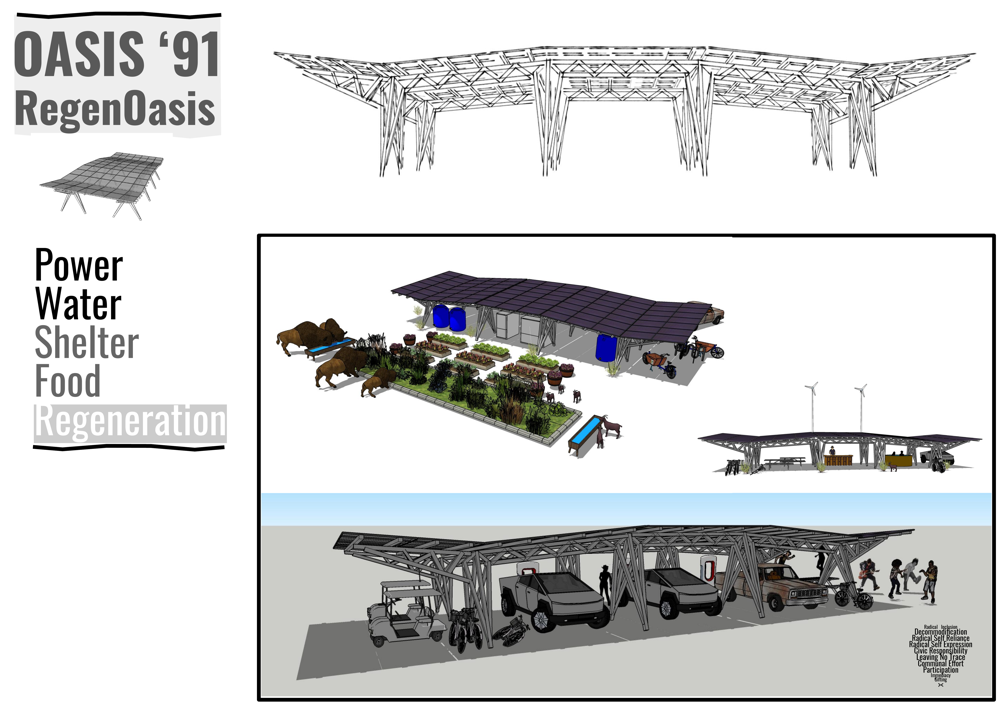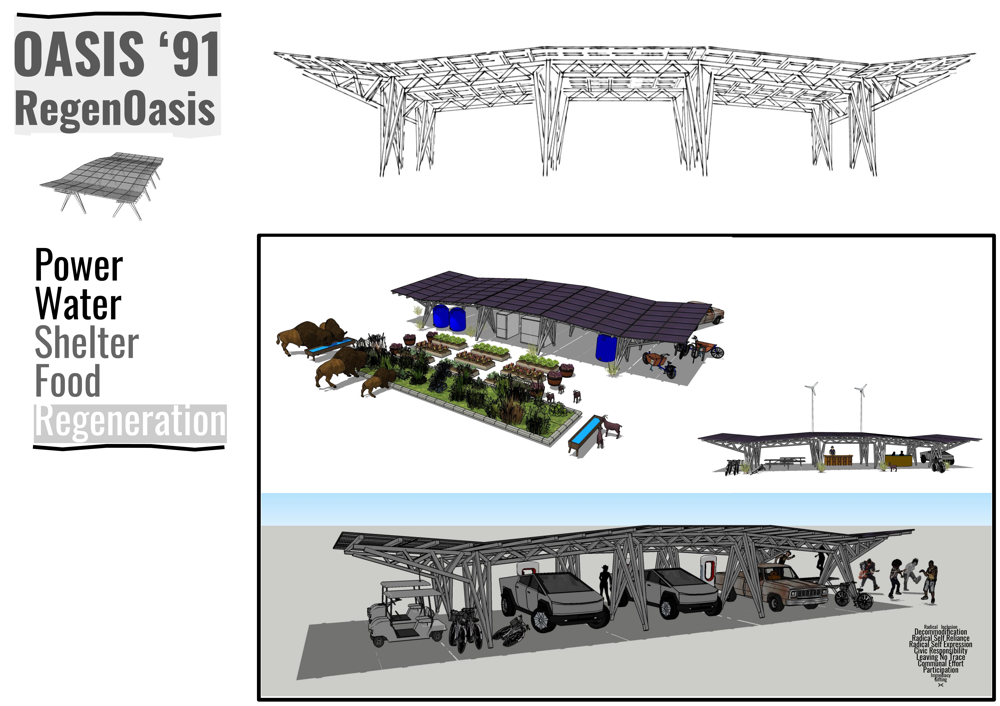
The RegenOasis - LAGI 2020 Fly Ranch Entries
Share
Narrative: Managing our Environmental Impact
An oasis in the desert, the RegenOasis is a shade structure consisting of 91 solar Photovoltaic (PV) panels that also serves as a rainwater harvesting surface. The structure provides a shelter that can be used for different purposes throughout the year depending on need. It also provides electric power that can be used to charge vehicles, power water filters, communication electronics, and whatever else is needed.
The shade structure provides an open air shelter area that can be used as a classroom, meeting area, workshop, carport / EV charging station, or all of the above on a rotating basis. The canopy has over 500 square feet of shaded area has over 8 feet of overhead clearance leaving plenty of room for all the activities.
The solar panels produce up to 33 kW during the day or roughly 61,447 kWh of energy per year. The structure is a welded aluminum canopy that is lightweight, corrosion resistant, and is designed to maximize the amount of shade provided with minimal use of structural materials.
The energy is stored in a grid optional battery and inverter system. If the grid is available, the system can operate in conjunction with the energy grid, lowering energy bills while providing a resilient power source if the grid goes down. If there is no grid, the system is a fully functional power system.
Rainwater is collected and stored in storage tanks. There is a filter system to make the water potable. Water is also supplied to various containers where it is used to maintain vegetation and provide food, shelter, and drinking water for local native species of animals as well as migrating birds, butterflies and pollinators.
Location
The proposed location for the initial install would be at the same location as the 1997 Burning Man Event site. The structure is a very functional space that can be configured for events, gatherings, classes, and celebrations.

Technology used in the design
The installation will use a set of complementary systems. Solar panels charge batteries and also collect rainwater. The synergy between water and energy is embodied in the design and function of the solar canopy. The layout of the solar panels creates a surface that naturally collects and directs the rainwater into the collection tanks.
Canopy Structure
The structure takes rectangular solar panels and supports them in a form that feels like it is an organic creature. The easily constructed design uses a system of trusses and triangles to support the solar array. The aluminum structures arrive at the site as a kit of legs and trusses that is quickly assembled.
POWER
The Solar + Storage Energy system
Sunlight is harvested using the photovoltaic (PV) panels. The energy from the solar canopy is stored in batteries. Inverters take the DC energy that is stored in the batteries and convert it to AC which is the usable form of power that can be used to run lights, sound system, water pumps and filters, electric vehicles, and more. The energy storage system is made of used electric car batteries. When electric vehicle batteries are retired they can be repurposed into an energy storage system. Reusing old EV batteries for energy storage gives them a “second life”, where they would normally get recycled or thrown out in landfill.
For this project we will use recycled Nissan Leaf battery modules and rebuild them into a new energy storage system. We have experience building energy storage systems from these batteries, such as in a large art car which uses these batteries too. Below are some photos of how we rebuild the battery modules into new packs for energy storage.

WATER
Rainwater and springwater can be captured, filtered, stored, and measured out for all uses, including irrigation for local flora and fauna. Water for grasses and sedges irrigates local flora to feed the bison and goats. Butterfly and bee friendly flowers and plants can help restore and rebalance the ecosystem.
The roughly 555 square feet of canopy area captures rainwater, utilizes a first wash flushout controller, and can store up to 500 gallons of rainwater. Gutters and pipes between panels route the water to the storage tank. The control system uses a first flush system prevents water from entering the tanks until after the incoming water is clear. The first few gallons of rainwater are diverted to the ground to clean the surfaces. Three 500 gallon tanks allow for 1000 gallons of rainwater storage and 500 gallons of filtered water storage.
SHELTER
Shade is critical for comfort in the desert. The outdoor temperatures in this part of Nevada regularly reach over 100F (40C) in the summer. Shade structures are an integral part of the Burning Man festival. They tend to be the first structure that gets built by a camp, and form the nexus point for community gatherings and social interactions. Center Camp is one of the first and biggest structures to be built in Black Rock City, and is both the geographic center as well as the cultural center of the city, while not necessarily at the center of the map. A large open shade structure still allows for air flow and breeze to flow through the structure and is engineered to withstand the high wind speeds that can be expected in the environment.
FOOD
Rainwater and springwater can be captured, filtered, stored, and measured out for many uses, including irrigation for local flora and fauna. The combination of rainwater and springwater provides plenty of water for growing plants or providing drinking water to livestock, migrating birds, pollinators, etc.
Activities the design would support
The space under the canopy is a comfortable open air environment, which can be used for gatherings, meetings, a workspace, or storage. The space is flexible and, depending on the configuration, can be configured as a workshop, a classroom, or any other number of uses. The energy and water provided by the RegenOasis can be used to support any number of needs.
System inputs
Depending on the final configuration decisions, the system can be mostly autonomous and require very little maintenance. If more water management is needed, more hands-on control will be required.
System outputs
The primary outputs are power and water. Secondary outputs can be food, space for events, shade and comfort.
Primary materials used and major dimensions
The canopy structure is made out of square tube aluminum and covers approximately 555 square feet. The solar panels are framed crystalline solar modules, the brand of module would be decided when it’s time to buy, based on the best pricing available. The batteries are used batteries from Nissan Leaf electric cars. The water tanks would be high density polyethylene (HDPE).
Cost estimates
Solar equipment: 30k
Canopy: 20k
Ground Grading: 2k
Batteries: 10k
Water pumps, tanks, and filters: 10k
Total: 72k
Detailed budget available on request.
Strategy for on-site construction
Many of the components would come partially pre assembled, such as the energy storage system and the canopy structure. This minimizes on site labor. Not much prototyping would be necessary. The technology is fairly well known. The only components that would need to be finalized would be the gutters between the solar modules.


1 comment
LOVE
LOVE
LOVE!!!!
Let me know if this moves forward. I will help with the build